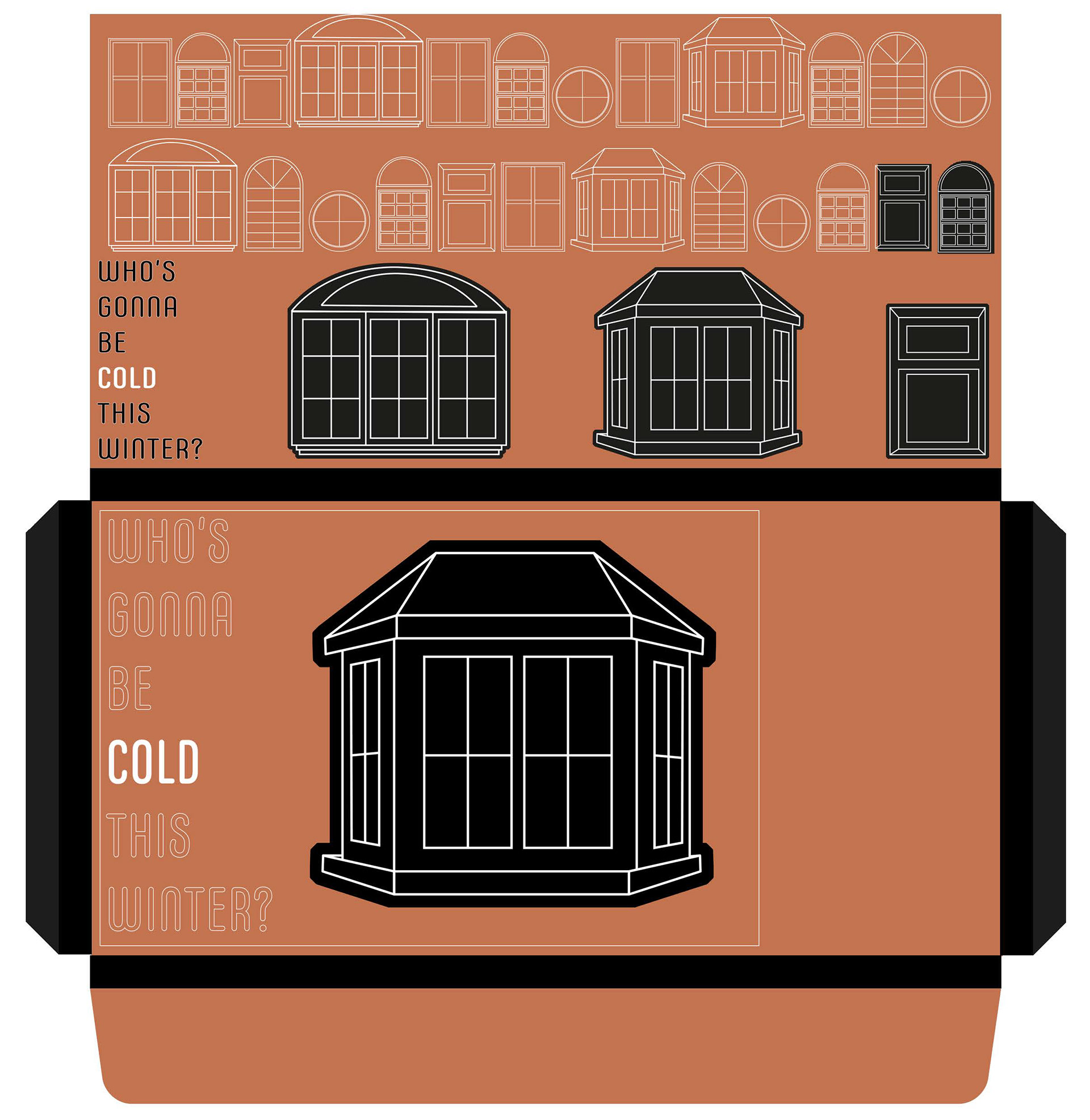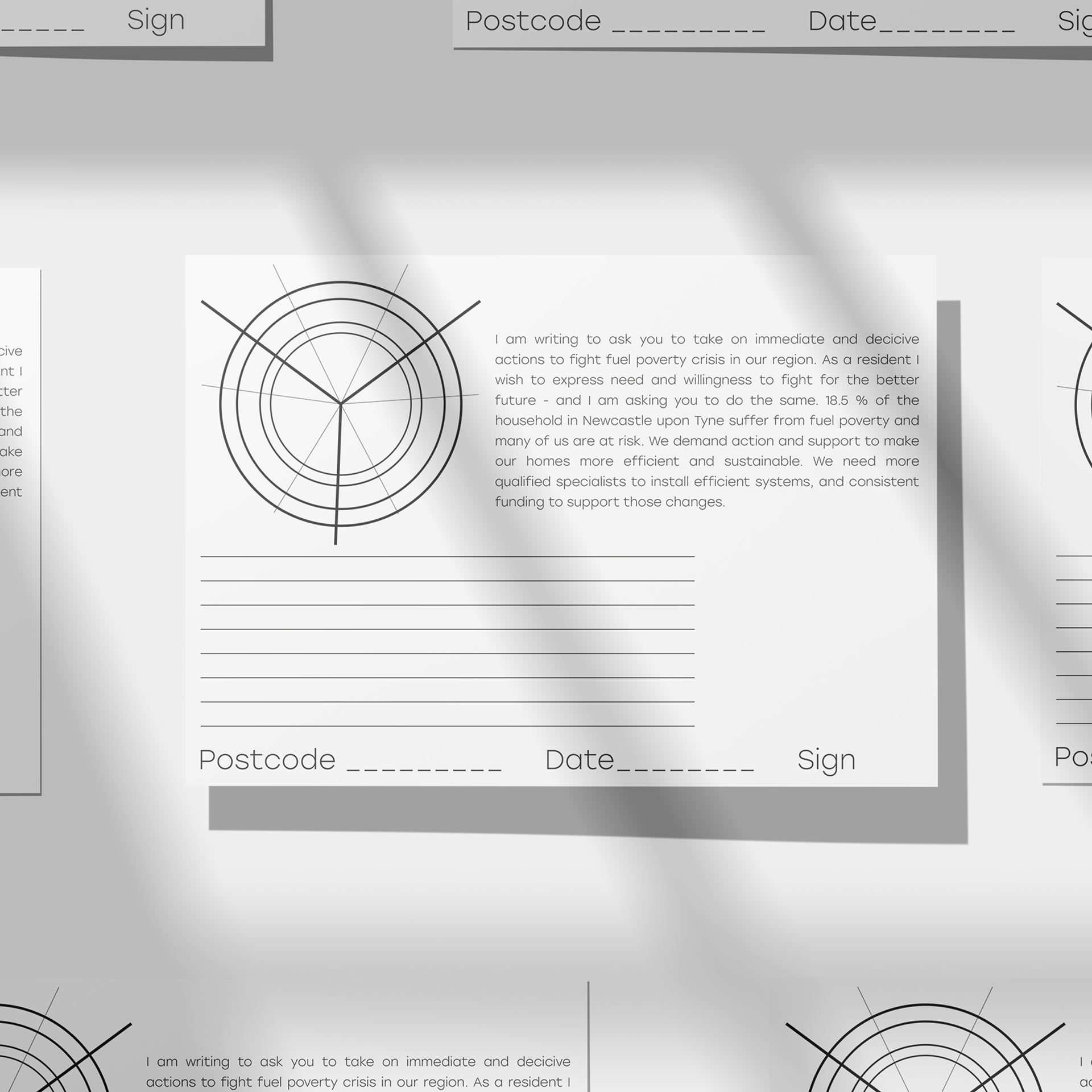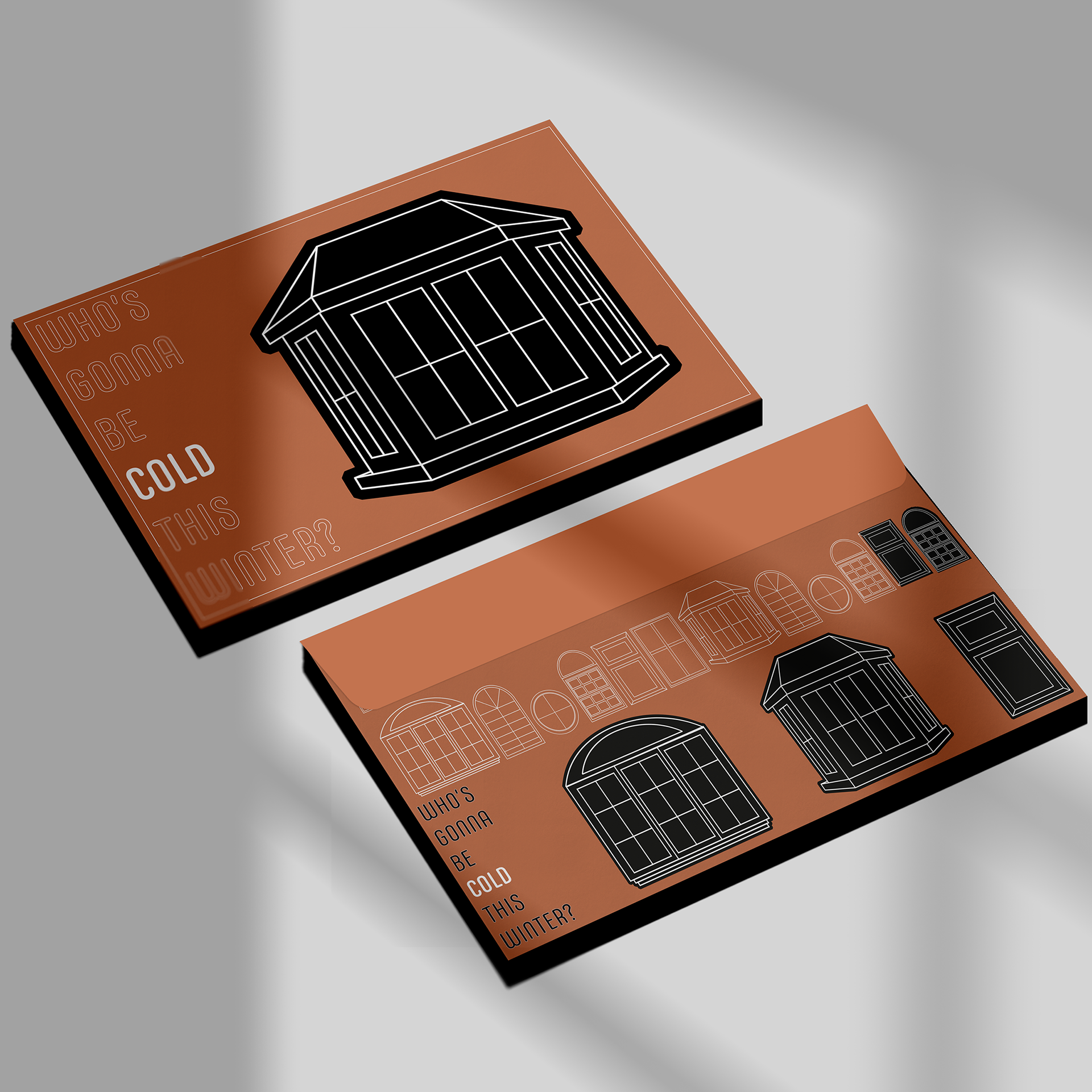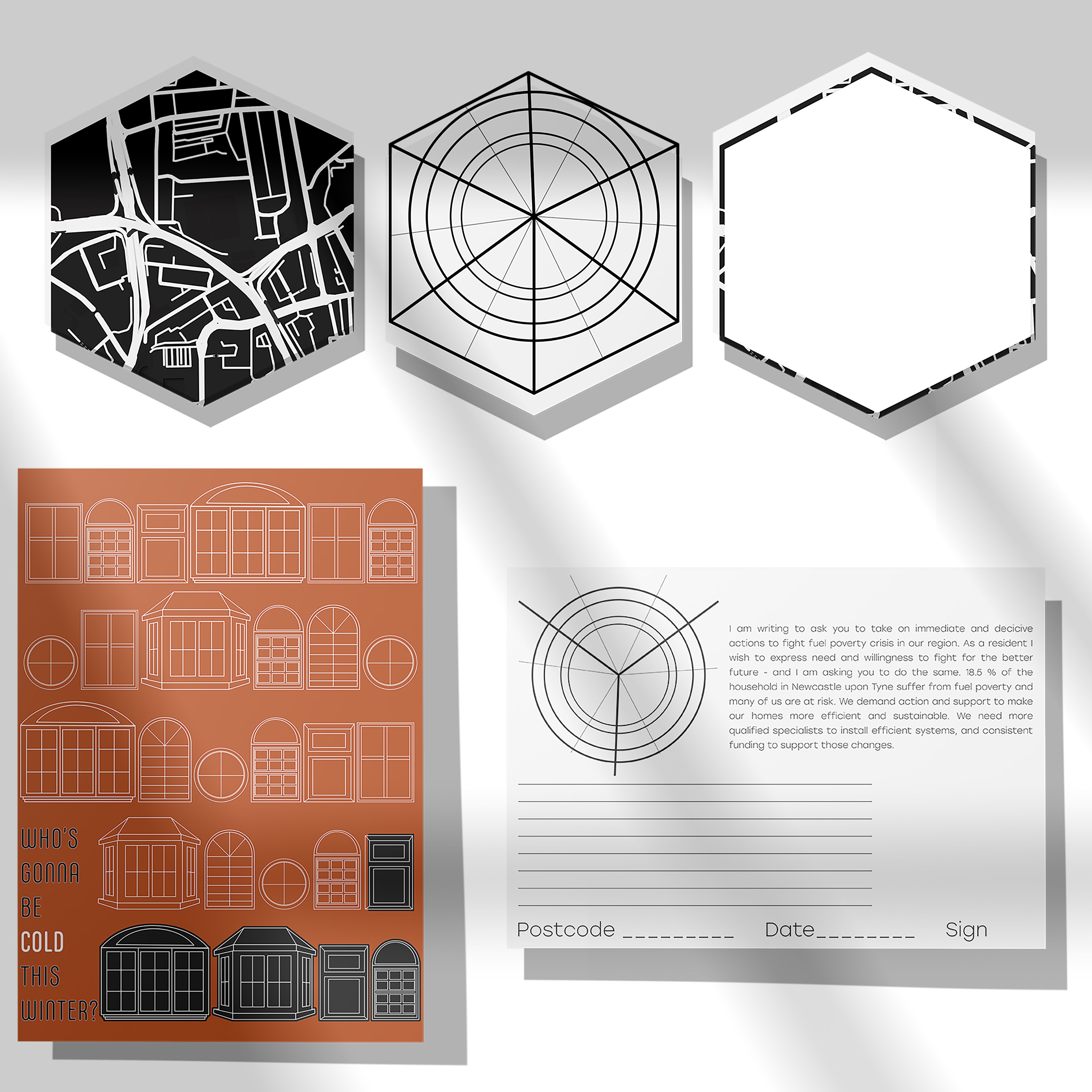I have spent two initial weeks of the project researching sustainability issues in the North East area. Because I was working on it on my own, I started with a very wide scope with the intention to find an interesting area of interest as soon as possible. In the first week, I focused on the three pillars of sustainability and tried to decide which one will be the most suitable for the project. I have looked at the Net Zero Newcastle 2030 action plan and compared it with other sources. I was very interested in solar panels usage, and the fact that there is no system in place to track domestic use of that technology.
I could find an article and research by Dan Stowell from the Alan Turing Institute. Their team was trying to map all of the UK solar panels into OpenStreetMap, but I could not find any recent updates. There are a lot of interesting materials about the photovoltaic potential for the area, but I did not feel like it is area specific enough. I tried to investigate the flooding risk as a result of climate change,
but the data was not clear enough to use as the core of my project, and if and frankly, I had no idea how I could measure such a thing not being a scientist myself. I was surprised that a lot of statistics for the use of renewable sources of energy in Newcastle are quite promising. Whilst there is still a long way to go and we are not acting anywhere near fast enough, there are steps being made to start
addressing some of the issues.
My first idea was a tear-off book that would have a similar function to tear-off calendars, but instead of counting days and months, they would represent the change that needs to be made. There is a strong link between the passing of time and the need to act on our environment. So far, our actions are just a bandaid and we need to spread the understanding that without serious changes and pressing big corporations and governments, we might face failure. I wanted to list big goals for our
area to allow people to recognize milestones we can achieve. Once the goal is achieved and all of the pages are torn off, and the Angel of the North is revealed - now with a new, updated identity with sustainability being an integral part of it.
Black and white illustrations based on the body of the Angel of the North. It would be a visual representation of different aspects of sustainability actions Newcastle upon Tyne will take. Black coverage will be representing a percentage showing the progress/future response based on the data I will collect. It will be achieved by using the histogram function of Photoshop in the process of image creation. Below the illustration, there will be a short description of what is being shown, what is
the goal, and what the current status is.
Pages would visually represent different aspects of sustainability plans the city has for the future, and how much is needed to achieve those goals. Data will be presented in the shape of the wingless Angel of the North. The main aim of the sculptor was to make the Angel symbolises the future, transition to the information age, hopes, and fears – and we cannot think about it without thinking about sustainability. The region will never be at its full potential and the Angel will not have full
spread wings until we will take control of the climate crisis and embrace sustainability practices in our everyday life.
Even though the Angel of the North is based in Gateshead, it represents the whole region.
Newcastle, as a capital, should be leading in setting the right example and be a true reflection of it. Newcastle United and its branding are very integral to the local identity. Even non-football fans associate those colours with the town; therefore, I think it would be a good aesthetic choice to make the illustrations black and white.
I could find an article and research by Dan Stowell from the Alan Turing Institute. Their team was trying to map all of the UK solar panels into OpenStreetMap, but I could not find any recent updates. There are a lot of interesting materials about the photovoltaic potential for the area, but I did not feel like it is area specific enough. I tried to investigate the flooding risk as a result of climate change,
but the data was not clear enough to use as the core of my project, and if and frankly, I had no idea how I could measure such a thing not being a scientist myself. I was surprised that a lot of statistics for the use of renewable sources of energy in Newcastle are quite promising. Whilst there is still a long way to go and we are not acting anywhere near fast enough, there are steps being made to start
addressing some of the issues.
My first idea was a tear-off book that would have a similar function to tear-off calendars, but instead of counting days and months, they would represent the change that needs to be made. There is a strong link between the passing of time and the need to act on our environment. So far, our actions are just a bandaid and we need to spread the understanding that without serious changes and pressing big corporations and governments, we might face failure. I wanted to list big goals for our
area to allow people to recognize milestones we can achieve. Once the goal is achieved and all of the pages are torn off, and the Angel of the North is revealed - now with a new, updated identity with sustainability being an integral part of it.
Black and white illustrations based on the body of the Angel of the North. It would be a visual representation of different aspects of sustainability actions Newcastle upon Tyne will take. Black coverage will be representing a percentage showing the progress/future response based on the data I will collect. It will be achieved by using the histogram function of Photoshop in the process of image creation. Below the illustration, there will be a short description of what is being shown, what is
the goal, and what the current status is.
Pages would visually represent different aspects of sustainability plans the city has for the future, and how much is needed to achieve those goals. Data will be presented in the shape of the wingless Angel of the North. The main aim of the sculptor was to make the Angel symbolises the future, transition to the information age, hopes, and fears – and we cannot think about it without thinking about sustainability. The region will never be at its full potential and the Angel will not have full
spread wings until we will take control of the climate crisis and embrace sustainability practices in our everyday life.
Even though the Angel of the North is based in Gateshead, it represents the whole region.
Newcastle, as a capital, should be leading in setting the right example and be a true reflection of it. Newcastle United and its branding are very integral to the local identity. Even non-football fans associate those colours with the town; therefore, I think it would be a good aesthetic choice to make the illustrations black and white.
My second idea was a human-sized sculpture of the Angel. The wings would be down and folded. Each aspect of the illustrations from my previous concept would be embedded into it. Once the goal is achieved, the respective piece will be removed from the sculpture and the wings will start unfolding and eventually raising - like a reversed Doomsday clock. In the case that we achieve all the goals, the
Angel will be reverted to its original form.
Angel will be reverted to its original form.
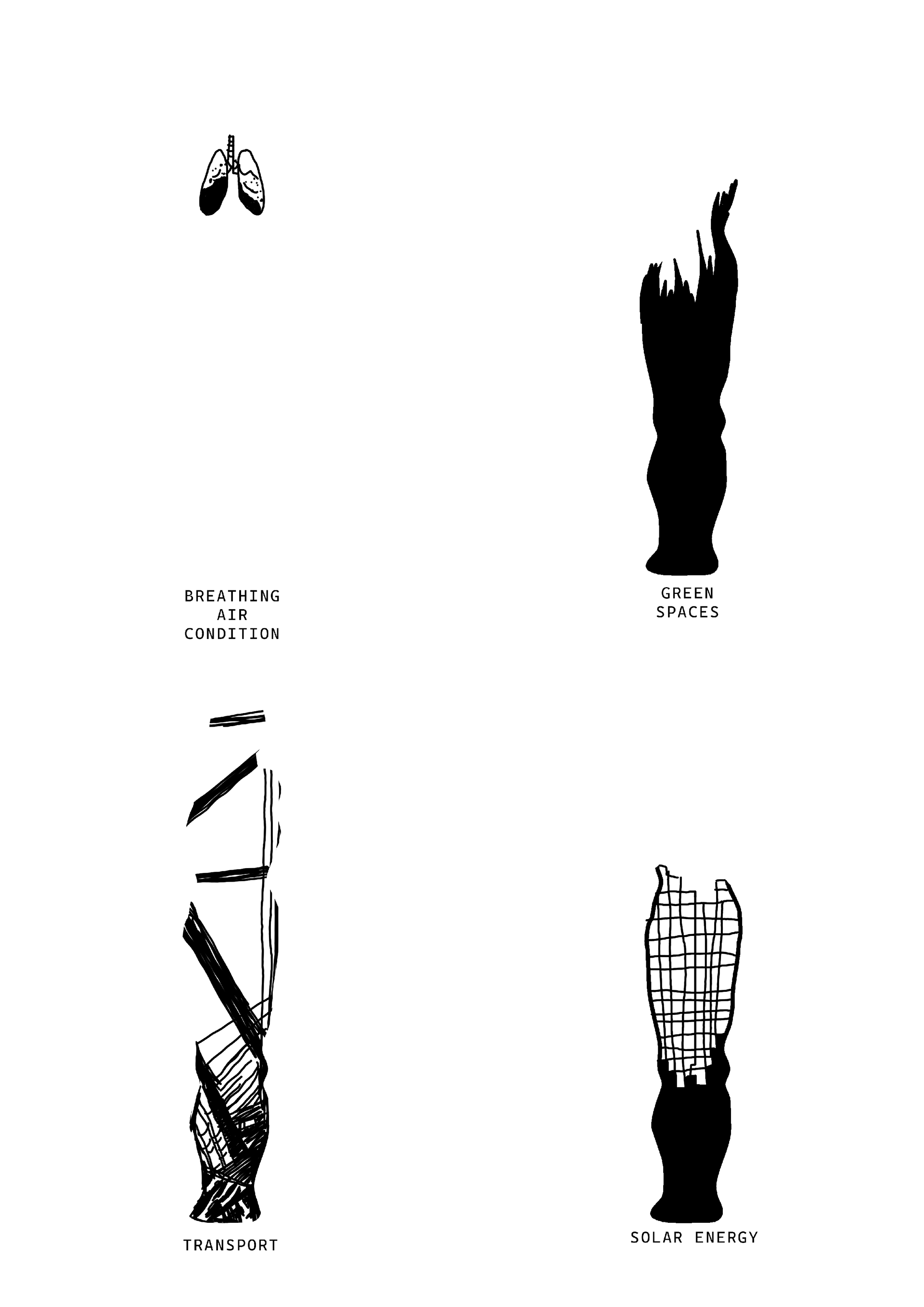
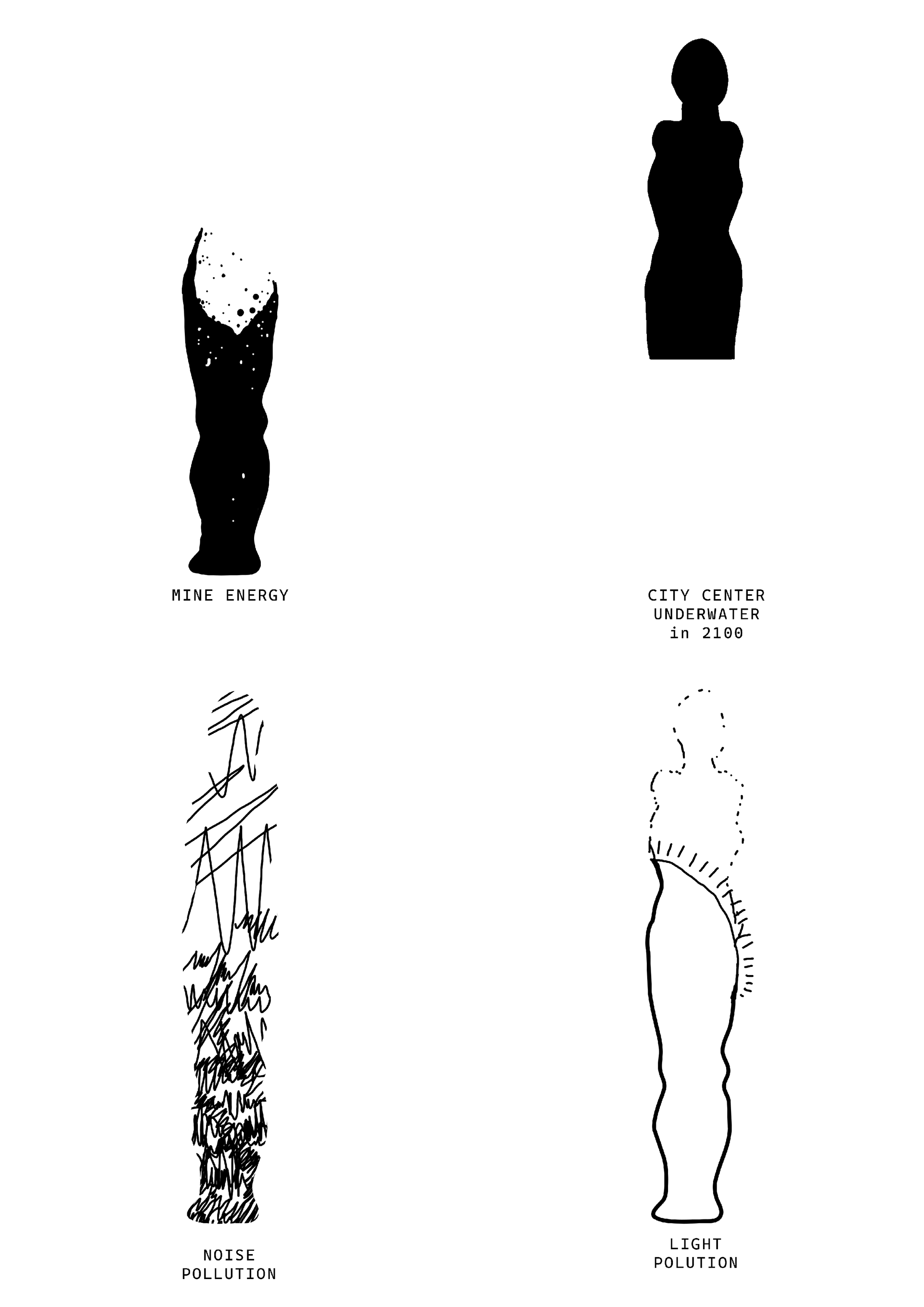
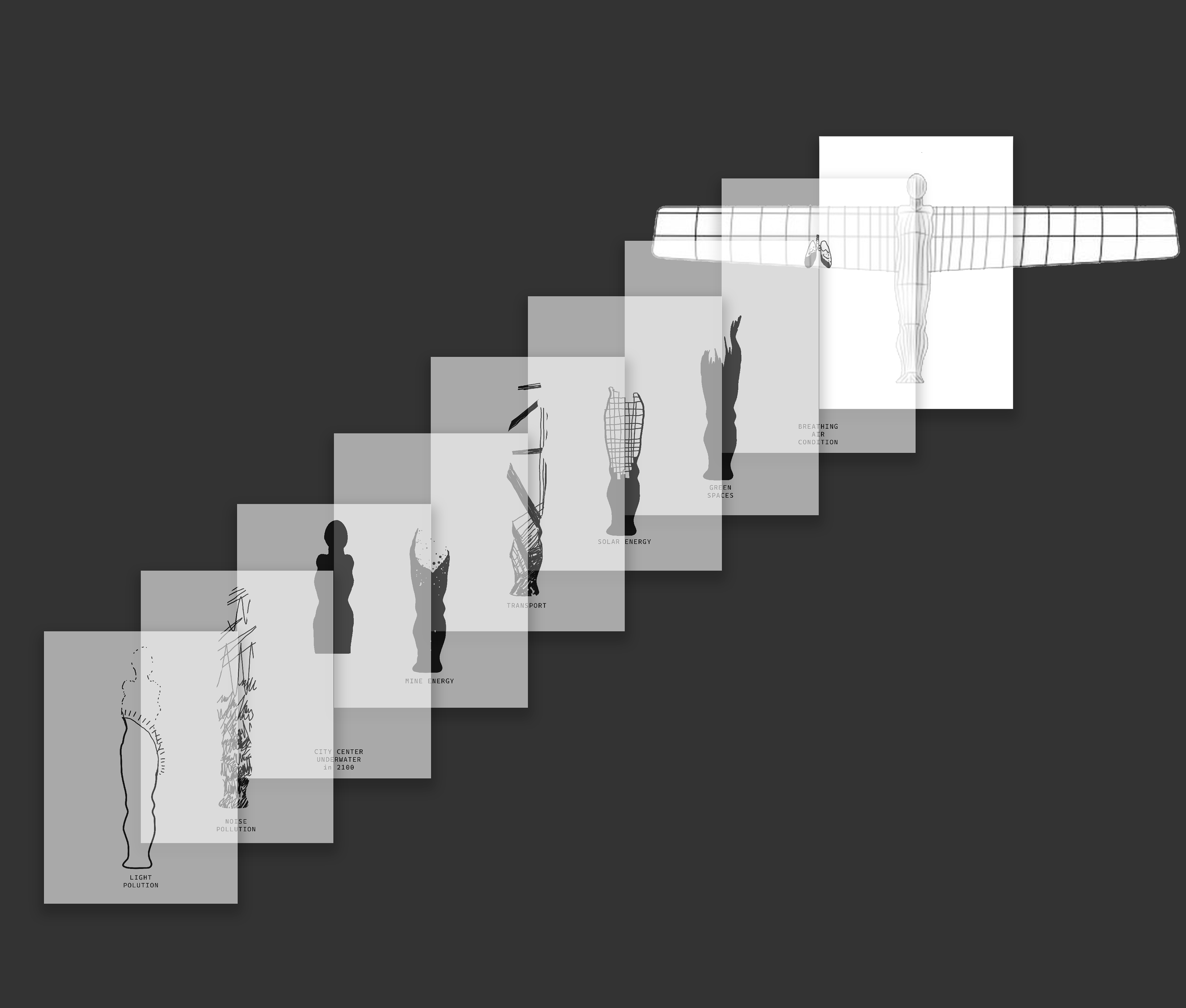


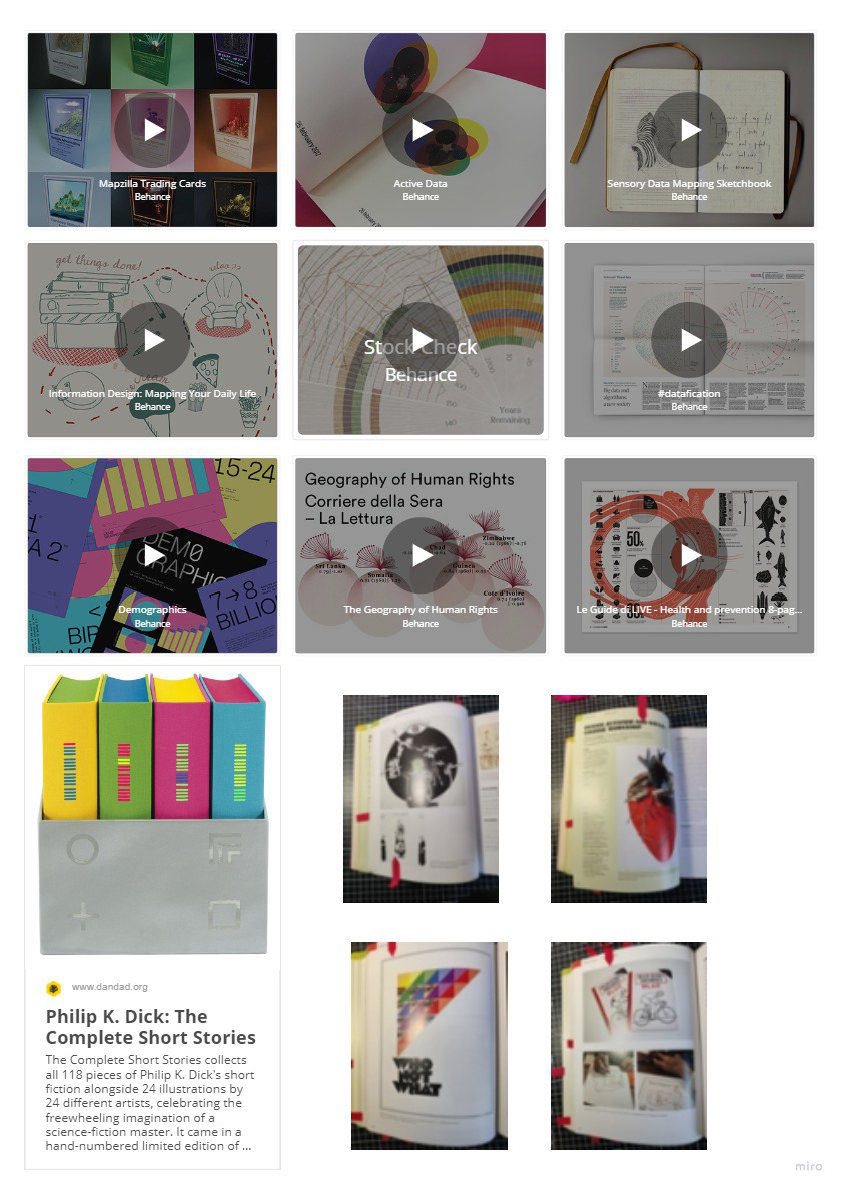
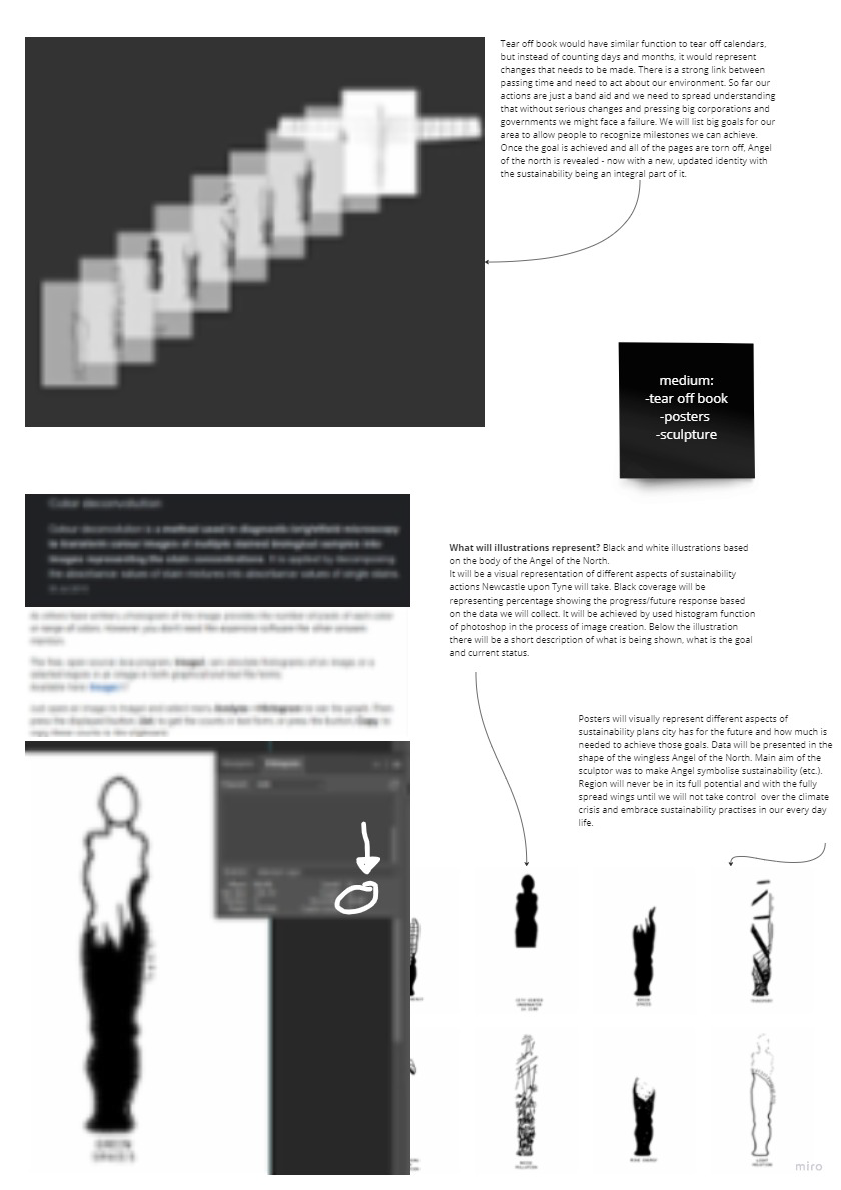
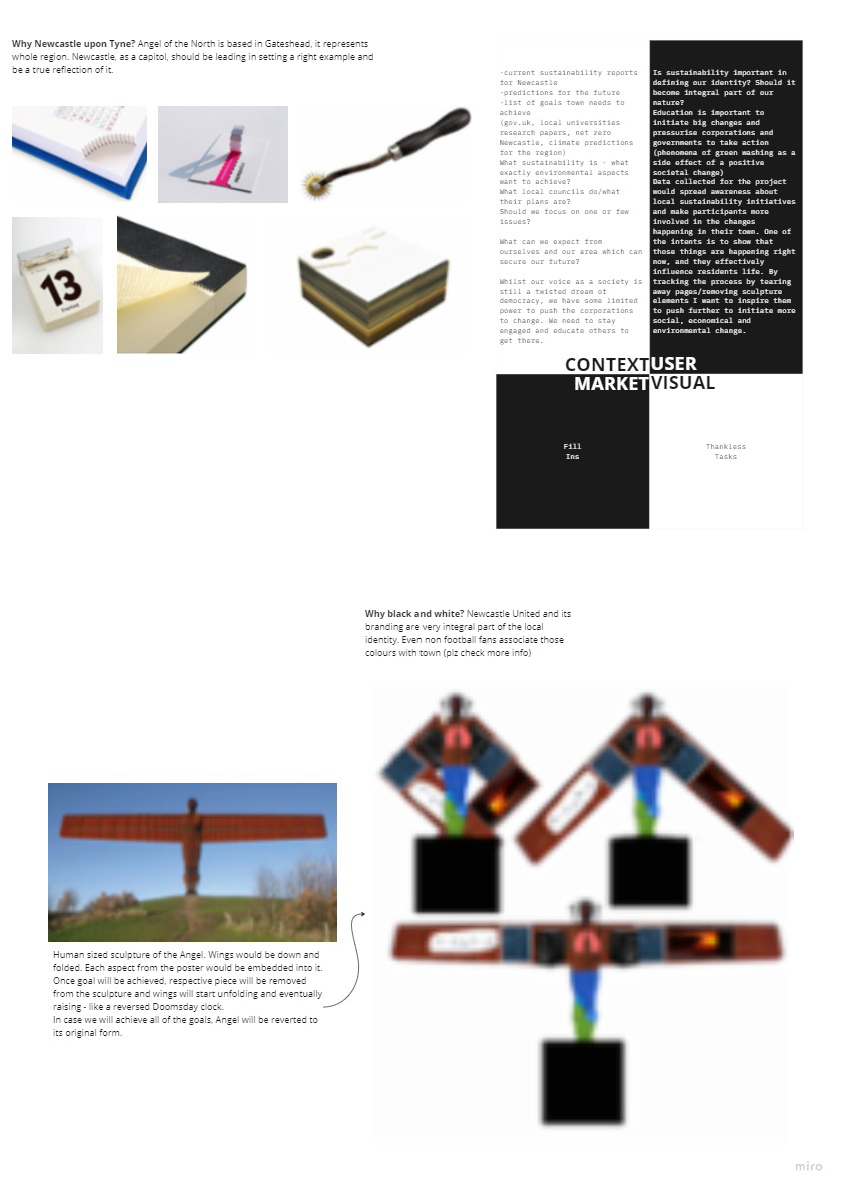
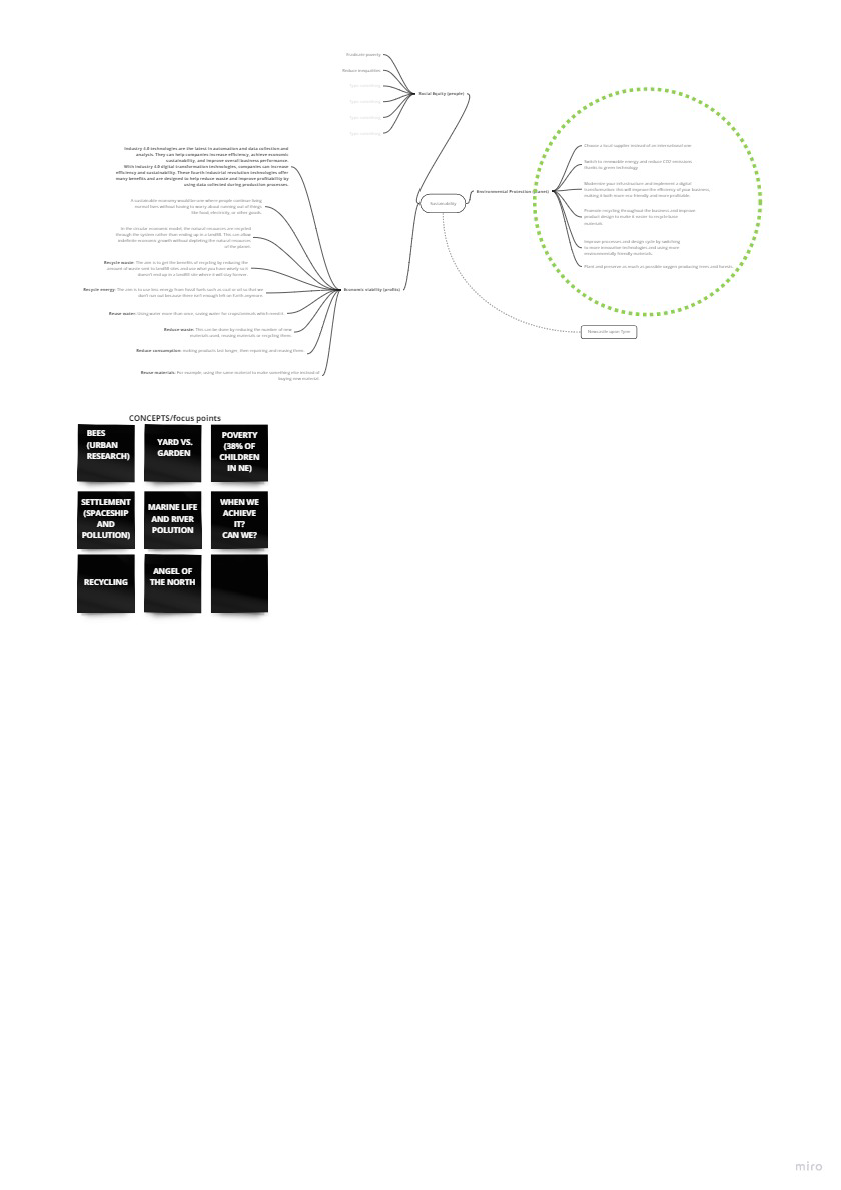
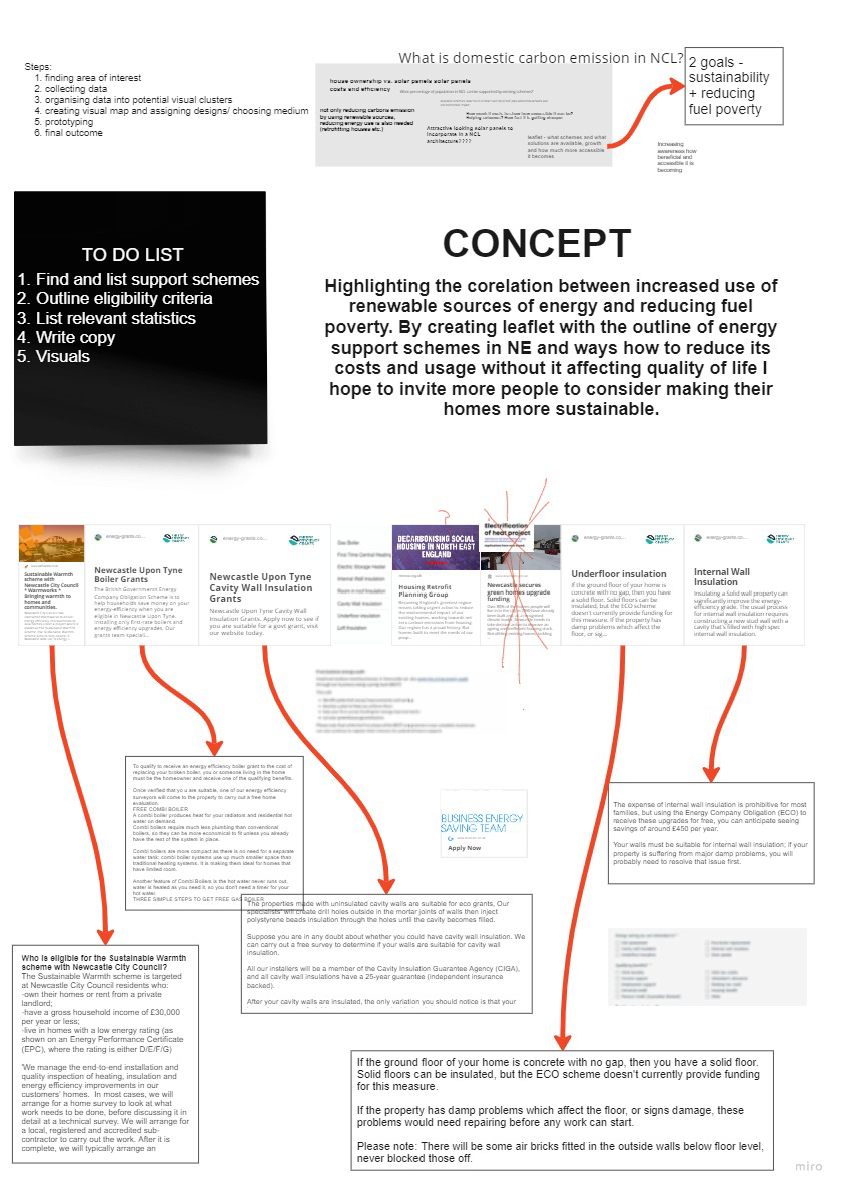
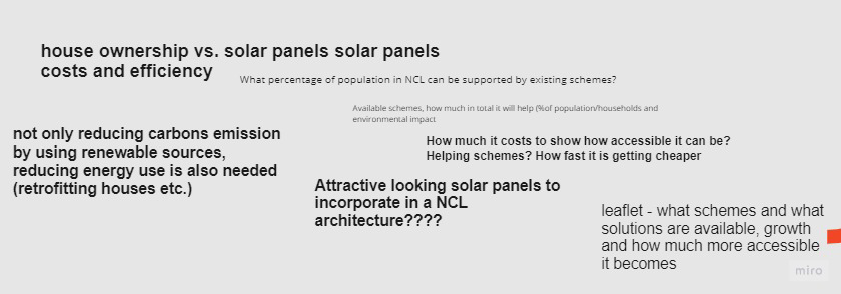
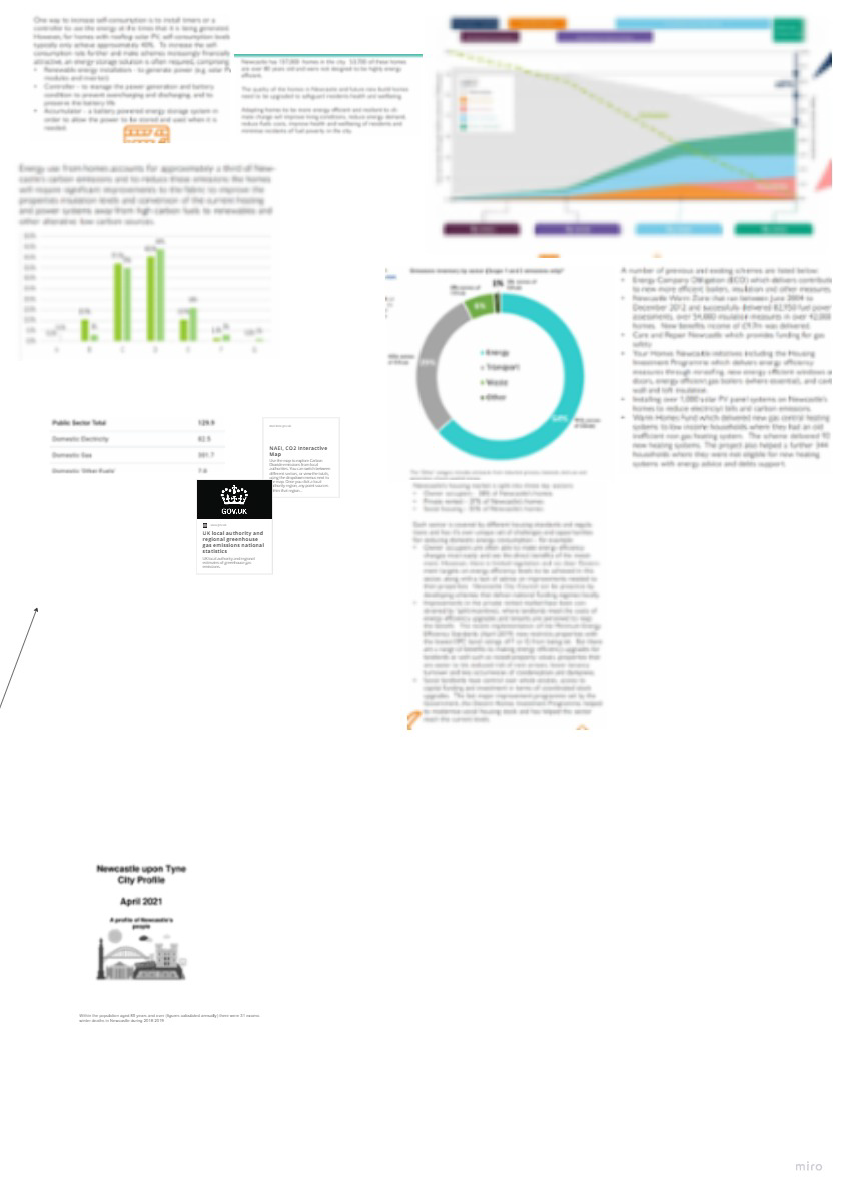

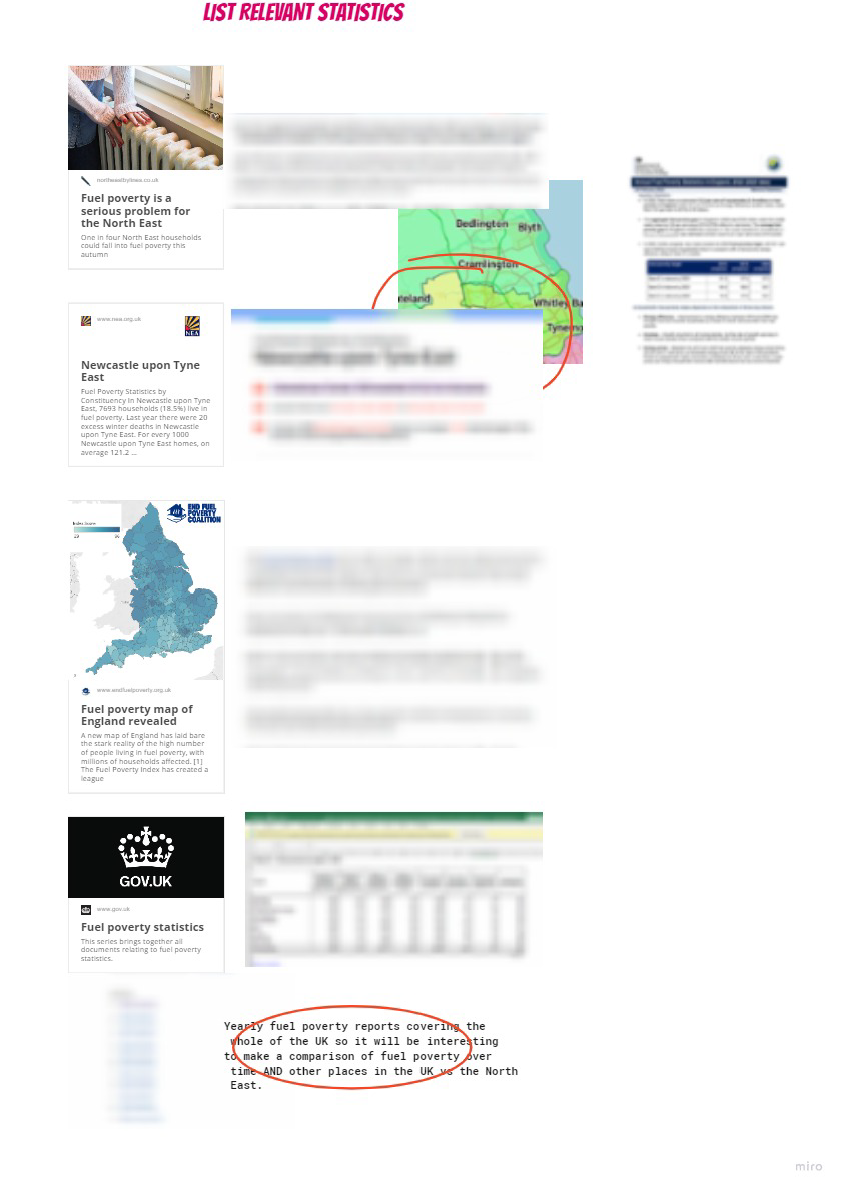
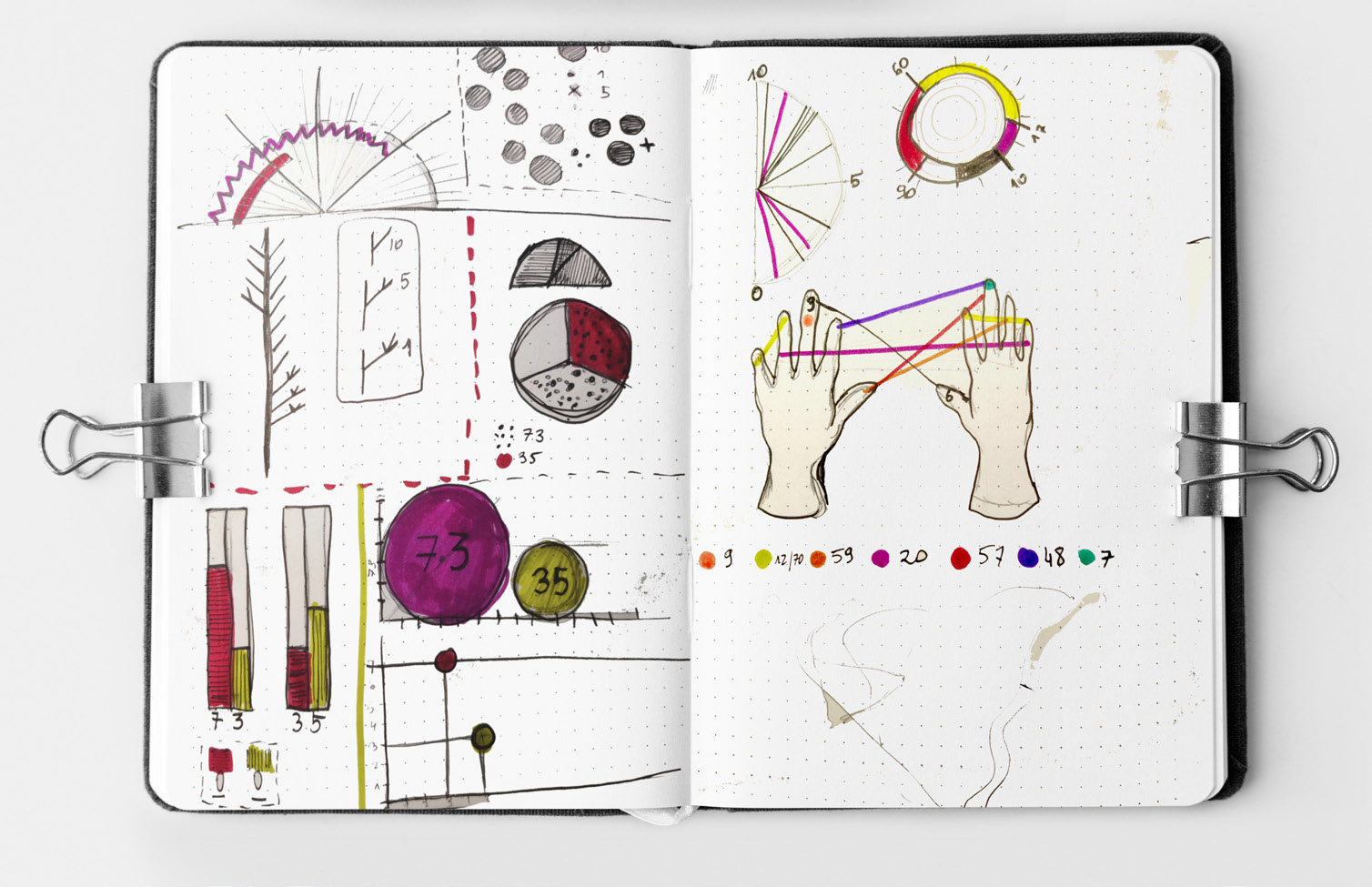

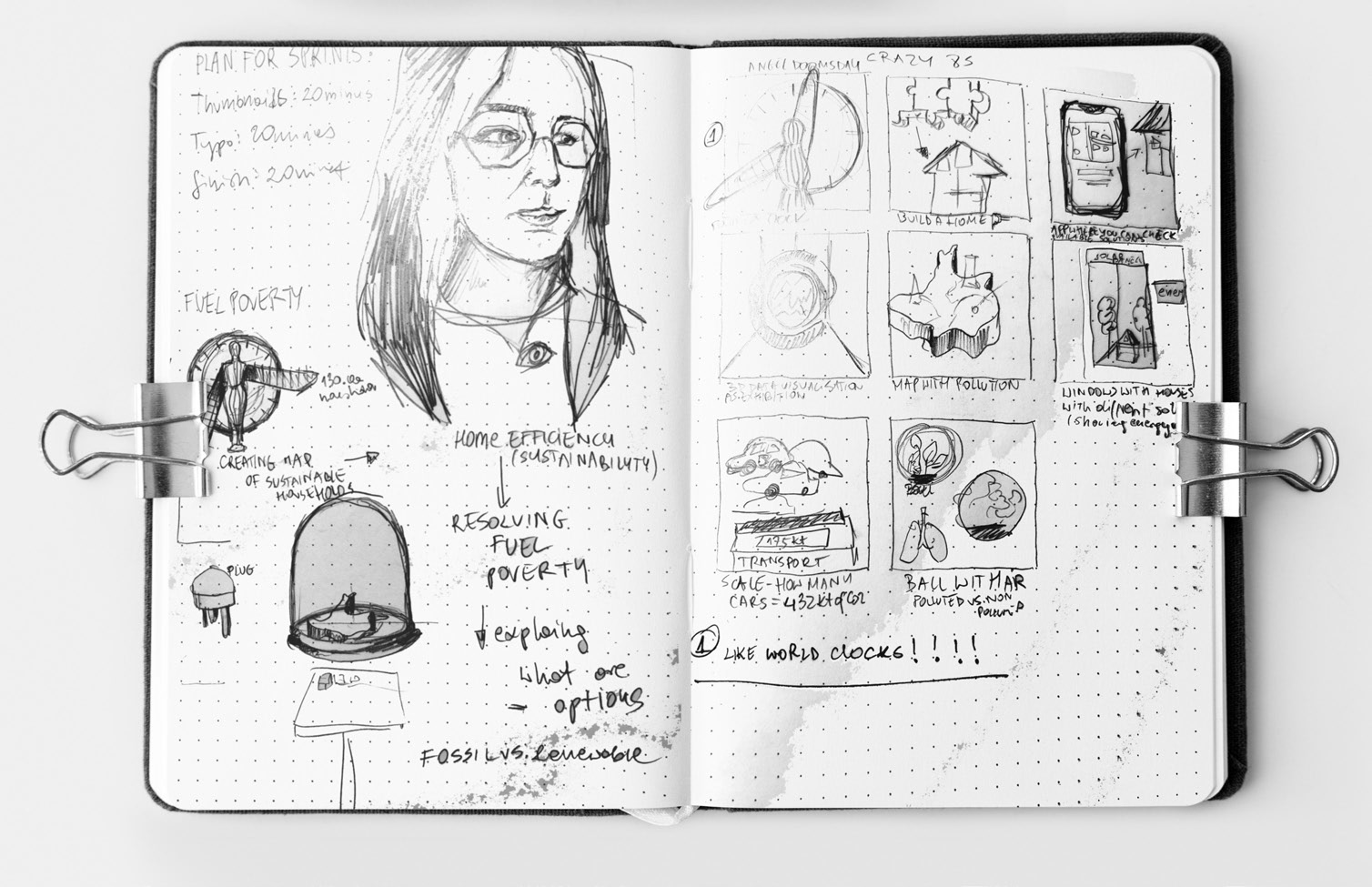
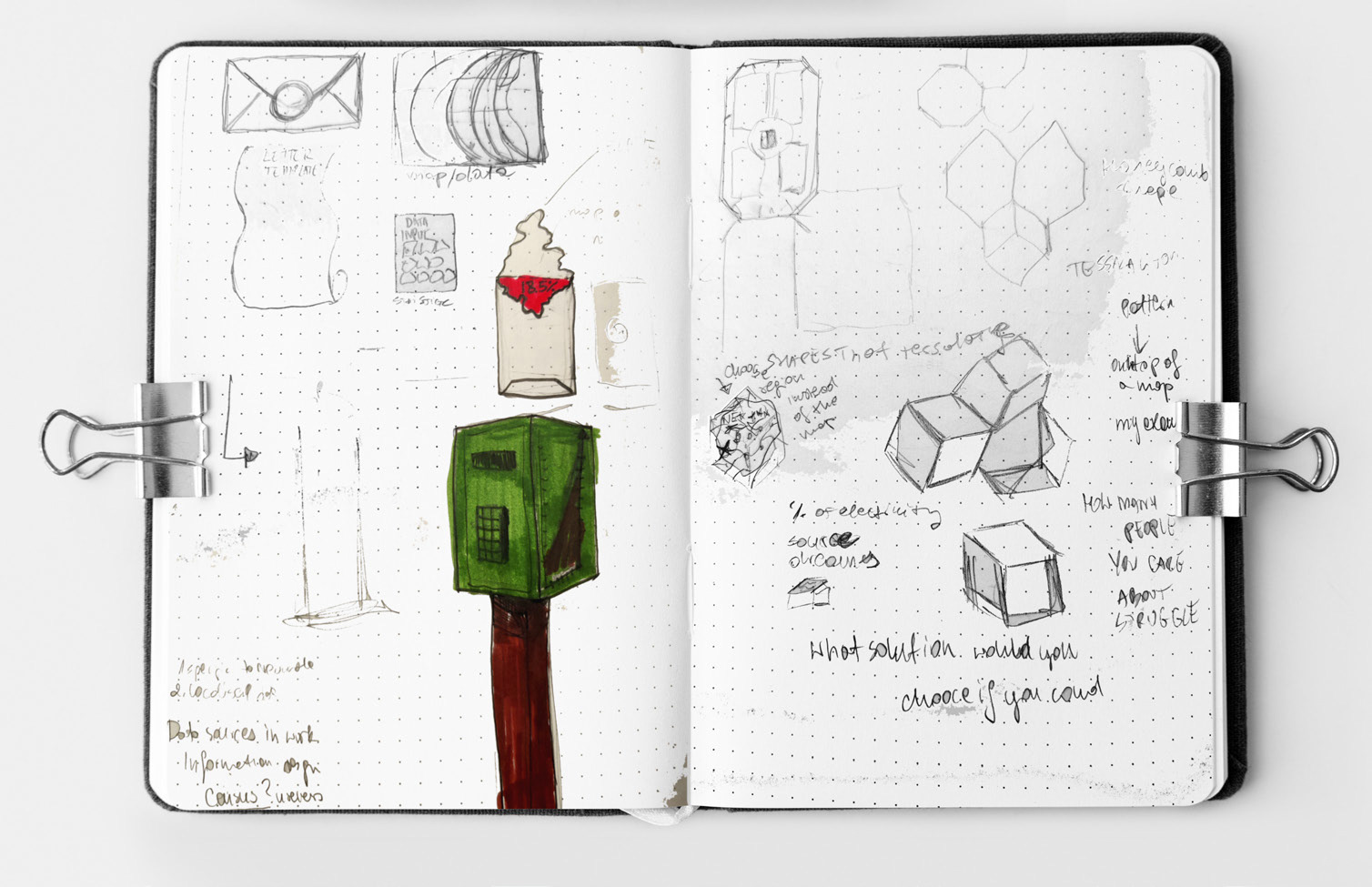
During my sessions with Joyce and Andrew, I had a chance to experiment a little bit with different ways to represent data. In most of my examples in the sketchbook. I was trying to vary my sketches, from those in which information is clearly displayed and those where it is more hidden in an aesthetic representation. That is when I found a perfect topic and decided to pursue the issue of fuel poverty. I designed a few mock-up posters and magazine spread but decided not to follow up with any of them.
The reason why I think fuel poverty subject is extremely relevant to the North East area is based on the data I found. 18.5% of households in Newcastle live in fuel poverty and at the same time, 1⁄3 of emissions come from the domestic sector. That clearly shows the area of my focus – the best solution to tackle the fuel poverty crisis and reduce emissions is to make our homes more sustainable. I consulted with my neighbour who works with government grants for renewable energy systems about that issue, and she highlighted my main struggle. The obvious main issue lies with the government scrapping support schemes and not increasing funding, but there are also other problems. We do not have enough specialists trained to retrofit our homes, and very often the installation of systems such as heat pumps is considered a failure. This is because it’s usually not done properly, and there is a lack of knowledge how to install and use sustainable energy sources – using heat pumps as an example again, homeowners may think they work similar to gas heating in which you just turn it on when required but this is not the case. Unfortunately, people suffering from fuel poverty mostly are not in a position in which they can have any control over those circumstances. That is why I decided that I will design a letter-writing campaign based on the local energy data. Shortly after that, I had to decide to move forward with the project on my own. This was because I had already spent over 2 weeks researching the topic and working on fuel poverty so I decided to keep it as my project subject.
The campaign, which I have called ‘Who’s gonna be cold this winter?’, would be aimed at residents of the region, adults, future and current house owners, and people at risk or suffering from fuel poverty. The goal of it is to highlight the correlation between the increased use of renewable sources of energy and reducing fuel poverty. Initially, I planned to create a leaflet with an outline of energy support schemes in the North East and ways how to reduce its costs and usage without it affecting their quality of life. I hope to invite more people to consider making their homes more sustainable. I designed a few pages whose purpose was to educate residents about the statistics related to fuel poverty and sustainable solutions in the area. I went with layered cut-outs and a graphic layout for the data. I created a few prototypes and began working on preparing files to print until the feedback session led me to modify my project. With the subject being strongly connected to the actual suffering of people in real-time, I decided to make a variation of a letter-writing campaign. The letter-writing kit would contain a leaflet, a letter and a cube – a small tool which would allow organisers of the campaign to collect data from participants. To make it more sustainable, the kit would be ordered directly from the website to people who are interested in using it, instead of just being given away and printed in silly quantities.
The reason why I think fuel poverty subject is extremely relevant to the North East area is based on the data I found. 18.5% of households in Newcastle live in fuel poverty and at the same time, 1⁄3 of emissions come from the domestic sector. That clearly shows the area of my focus – the best solution to tackle the fuel poverty crisis and reduce emissions is to make our homes more sustainable. I consulted with my neighbour who works with government grants for renewable energy systems about that issue, and she highlighted my main struggle. The obvious main issue lies with the government scrapping support schemes and not increasing funding, but there are also other problems. We do not have enough specialists trained to retrofit our homes, and very often the installation of systems such as heat pumps is considered a failure. This is because it’s usually not done properly, and there is a lack of knowledge how to install and use sustainable energy sources – using heat pumps as an example again, homeowners may think they work similar to gas heating in which you just turn it on when required but this is not the case. Unfortunately, people suffering from fuel poverty mostly are not in a position in which they can have any control over those circumstances. That is why I decided that I will design a letter-writing campaign based on the local energy data. Shortly after that, I had to decide to move forward with the project on my own. This was because I had already spent over 2 weeks researching the topic and working on fuel poverty so I decided to keep it as my project subject.
The campaign, which I have called ‘Who’s gonna be cold this winter?’, would be aimed at residents of the region, adults, future and current house owners, and people at risk or suffering from fuel poverty. The goal of it is to highlight the correlation between the increased use of renewable sources of energy and reducing fuel poverty. Initially, I planned to create a leaflet with an outline of energy support schemes in the North East and ways how to reduce its costs and usage without it affecting their quality of life. I hope to invite more people to consider making their homes more sustainable. I designed a few pages whose purpose was to educate residents about the statistics related to fuel poverty and sustainable solutions in the area. I went with layered cut-outs and a graphic layout for the data. I created a few prototypes and began working on preparing files to print until the feedback session led me to modify my project. With the subject being strongly connected to the actual suffering of people in real-time, I decided to make a variation of a letter-writing campaign. The letter-writing kit would contain a leaflet, a letter and a cube – a small tool which would allow organisers of the campaign to collect data from participants. To make it more sustainable, the kit would be ordered directly from the website to people who are interested in using it, instead of just being given away and printed in silly quantities.
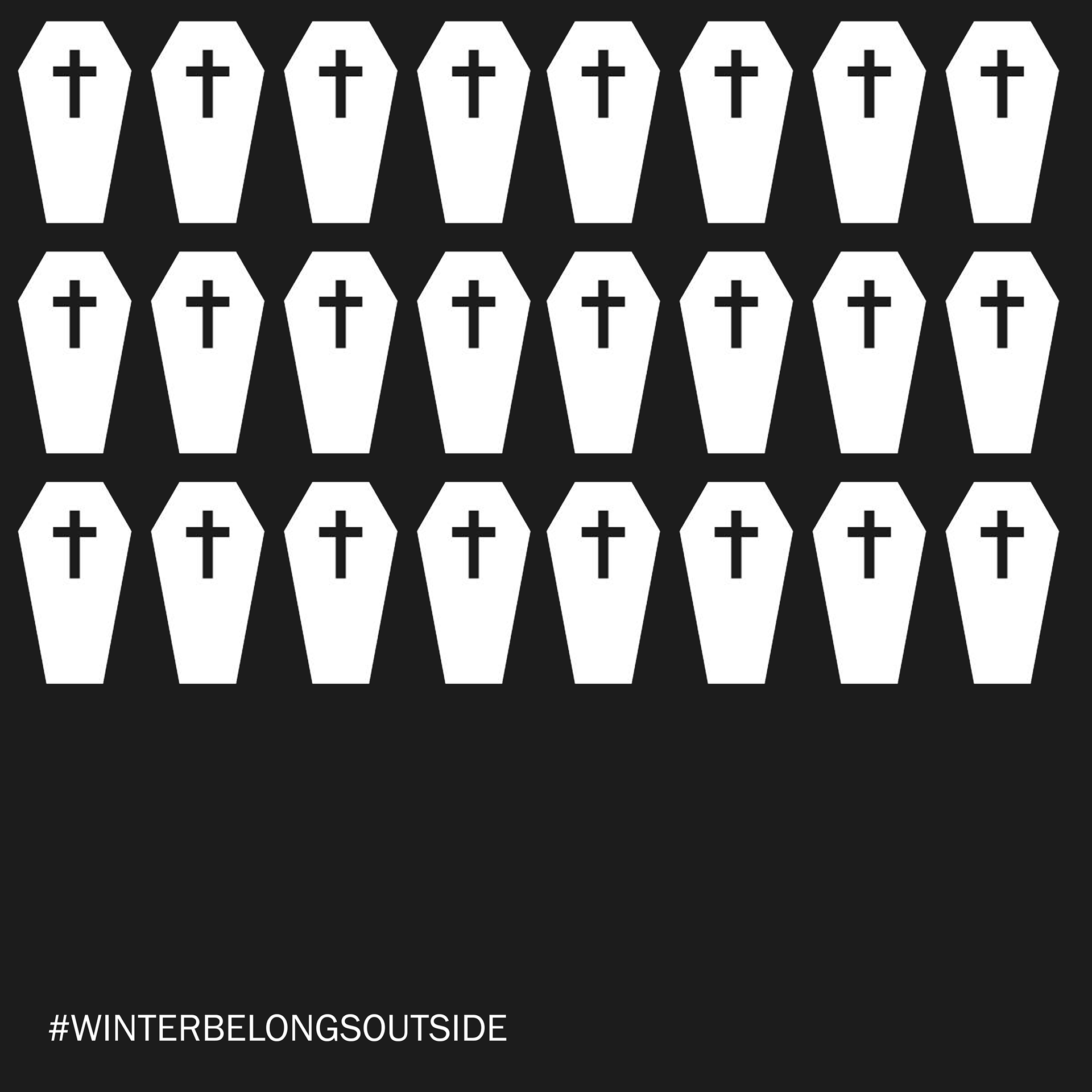


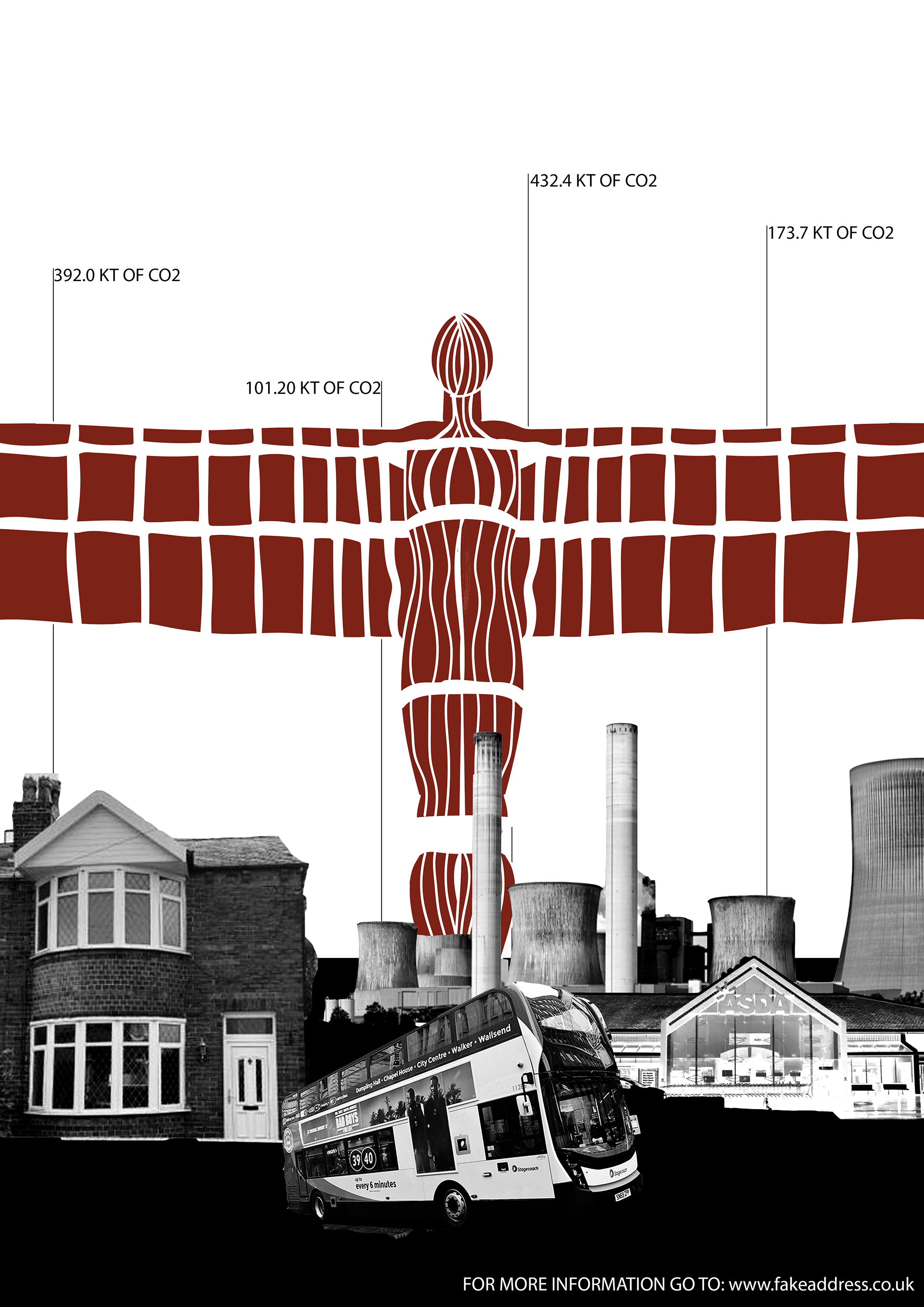
My chosen colour scheme, which initially was just black and white, has got one additional colour. It was meant to be associated with the rusty colour of the Angel of the North. I created a pattern for use within the project using mapbox.com. This allowed me to create a personalised map of Newcastle.
I designed some early versions of the envelope, leaflets and cubes, but during another feedback session, Andrew suggested that I should focus on the website aspect of the project. I have spent the last two days of the project focusing on it. I wanted to create an infographic parallax type of page, but due to the time constraints and the fact that I made every element from scratch, I had only a low-fidelity prototype to present. After the presentation, I focused on the original core of my project, with small changes. There are a few different ways we, as a society, can express our disappointment and present demands to our leaders. For this project, I decided to choose one of these different ways – a letter-writing campaign, as my main focus. I designed an ‘order in’ kit aimed at residents of Newcastle upon Tyne.

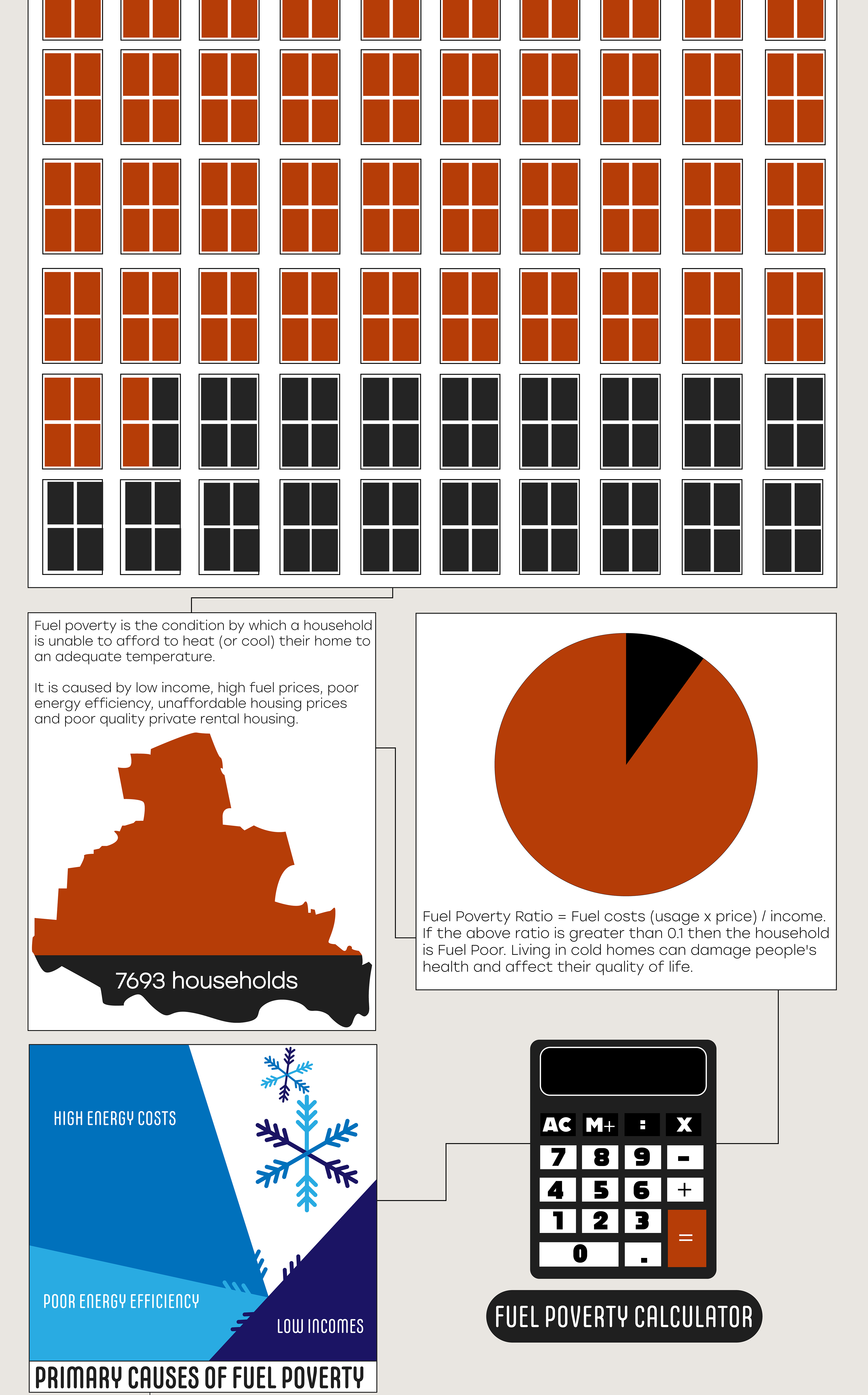
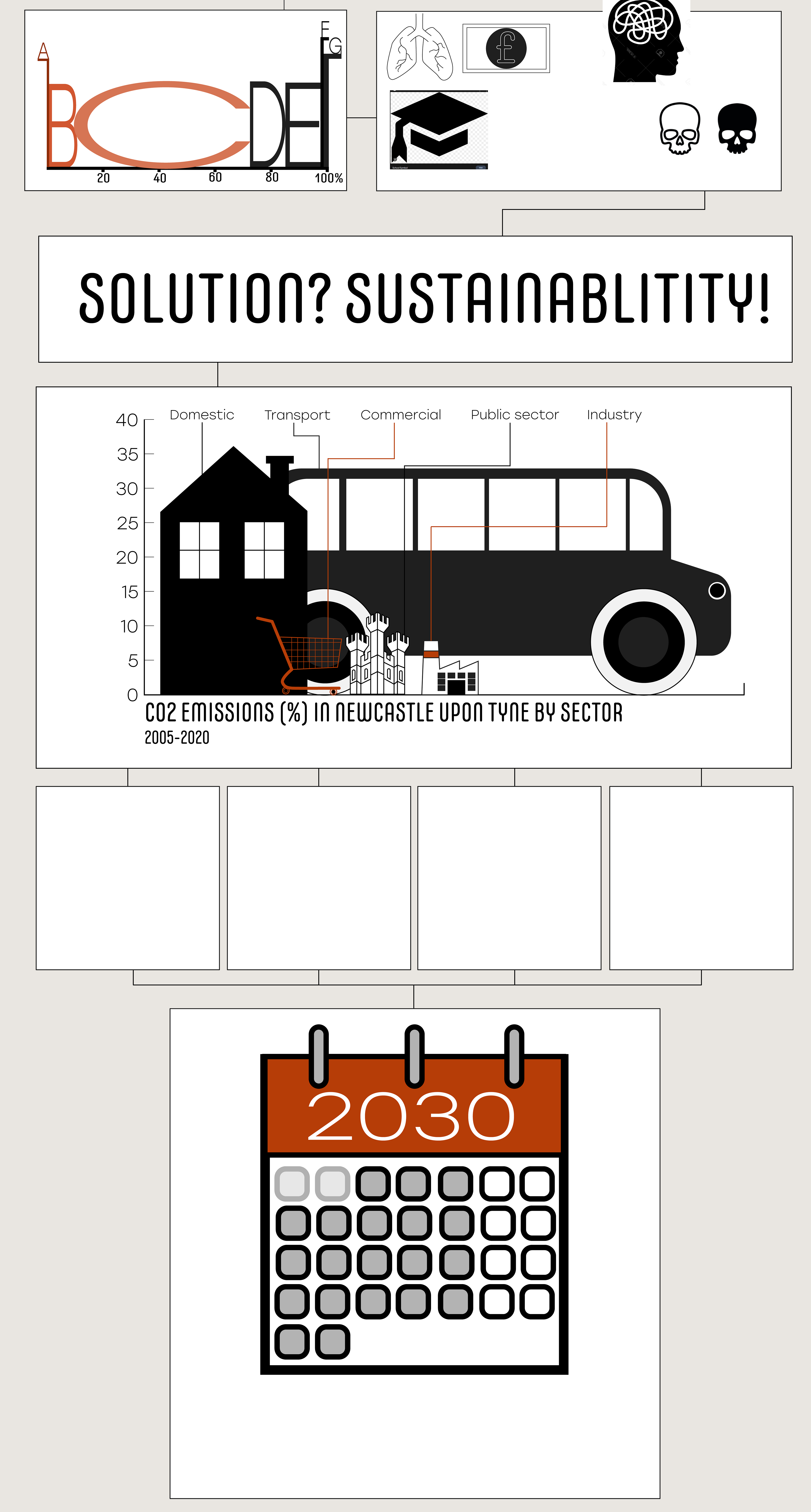


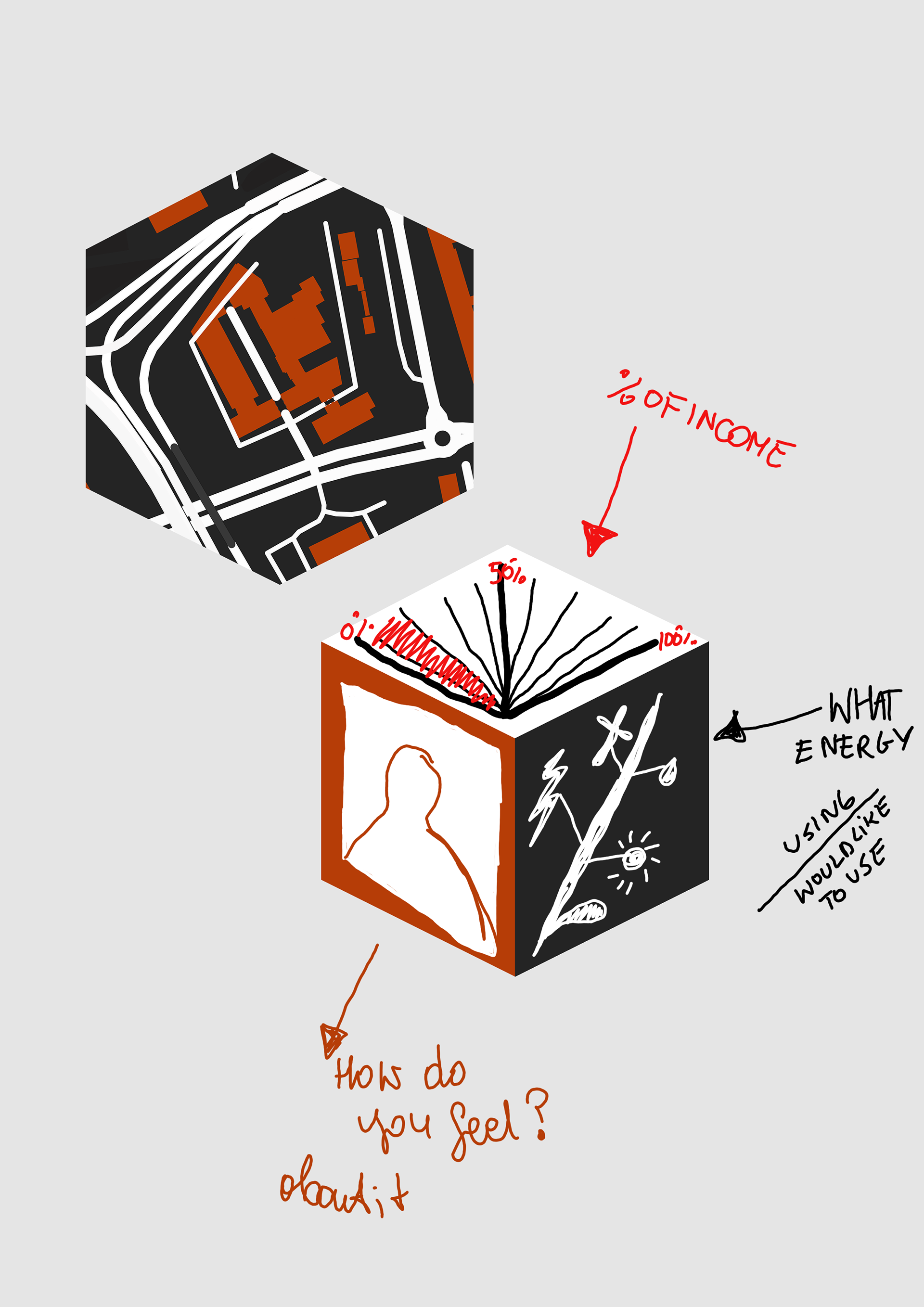

Fuel poverty in our region reached a dangerous
18.5%. 7693 households will not be able to
heat up their homes, and much more need to
calculate, plan and delay when they will turn
the heating on, just to avoid the incredibly
high costs which will follow. With over 1/3 of
CO2 emissions in Newcastle originating from
the domestic sector, there is only one perfect
solution – to make the future better, we need
to immediately put more focus on creating
our homes more efficient and sustainable. But
this does not come without costs. Residents
need efficient and constant support from
the government to achieve those goals. We
also need a range of qualified specialists who
can install sustainable systems in our homes
correctly.
My letter kit would include two important
elements. The first of which is a statistics
cube, which will allow residents to insert
various statistical information and express
their feelings about the crisis. After compiling
the completed cubes together, I would be able
to collect crowdsourced data and present it to
the council or create a local exhibit. Secondly,
a postcard will be included with pre-written
communication aimed at MPs, which would
be collected and in bulk presented to the
council to create a stronger effect. Residents
will also be able to add their own personalized
messages, as well as the information provided
previously in the cube to provide a stronger
message.
18.5%. 7693 households will not be able to
heat up their homes, and much more need to
calculate, plan and delay when they will turn
the heating on, just to avoid the incredibly
high costs which will follow. With over 1/3 of
CO2 emissions in Newcastle originating from
the domestic sector, there is only one perfect
solution – to make the future better, we need
to immediately put more focus on creating
our homes more efficient and sustainable. But
this does not come without costs. Residents
need efficient and constant support from
the government to achieve those goals. We
also need a range of qualified specialists who
can install sustainable systems in our homes
correctly.
My letter kit would include two important
elements. The first of which is a statistics
cube, which will allow residents to insert
various statistical information and express
their feelings about the crisis. After compiling
the completed cubes together, I would be able
to collect crowdsourced data and present it to
the council or create a local exhibit. Secondly,
a postcard will be included with pre-written
communication aimed at MPs, which would
be collected and in bulk presented to the
council to create a stronger effect. Residents
will also be able to add their own personalized
messages, as well as the information provided
previously in the cube to provide a stronger
message.
The project has 3 main goals:
1. Spreading awareness about fuel
poverty in the Newcastle upon Tyne region
2. Collecting data from residents
3. Creating a compiled letter to pressure
the council into taking immediate actions
1. Spreading awareness about fuel
poverty in the Newcastle upon Tyne region
2. Collecting data from residents
3. Creating a compiled letter to pressure
the council into taking immediate actions
